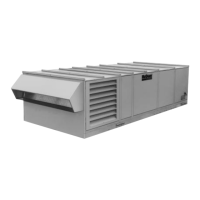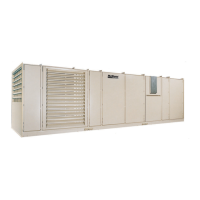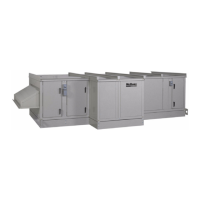30 McQuay IM 987
Mechanical Installation
Charging the System
Units are leak tested at the factory and shipped with a nitrogen
holding charge. If the holding charge has been lost due to
shipping damage, charge the system with enough refrigerant to
raise the unit pressure to 30 psig after first repairing the leaks
and evacuating the system.
1 After all refrigerant piping is complete and the system is
evacuated, it can be charged as described in the
paragraphs following. Connect the refrigerant drum to
the gauge port on the liquid shutoff valve and purge the
charging line between the refrigerant cylinder and the
valve. Then open the valve to the mid position.
2 If the system is under a vacuum, stand the refrigerant
drum with the connection up, open the drum, and break
the vacuum with refrigerant gas.
3 With a system gas pressure higher than the equivalent of
a freezing temperature, invert the charging cylinder and
elevate the drum above the condenser. With the drum in
this position and the valves open, liquid refrigerant flows
into the condenser. Approximately 75% of the total
requirement estimated for the unit can be charged in this
manner.
4 After 75% of the required charge enters the condenser,
reconnect the refrigerant drum and charging line to the
suction side of the system. Again, purge the connecting
line, stand the drum with the connection side up, and
place the service valve in the open position.
Important: At this point, interrupt the charging procedure and
do prestart checks before attempting to complete the
refrigerant charge.
Note: Stamp the total operating charge per circuit on the unit
nameplate for future reference.
Take special care to add refrigerant slowly enough to the
suction to prevent damage. Adjust the charging tank hand
valve so liquid leaves the tank but vapor enters the compressor.
Table 7: Pressure-Vacuum Equivalents
Absolute pressure above zero Vacuum below 1 atmosphere
Approximate fraction
of 1 atmosphere
H
2
O boiling point at each
pressure (
o
F)
Microns PSIA Mercury (mm) Mercury (in)
0 0 760.00 29.921 — —
50 0.001 759.95 29,920 1/15,200 –50
100 0.002 759.90 29.920 1/7,600 –40
150 0.003 759.85 29.920 1/5,100 –33
200 0.004 759.80 29.910 1/3,800 –28
300 0.006 759.70 29.910 1/2,500 –21
500 0.009 759.50 29.900 1/1,520 –12
1,000 0.019 759.00 29.880 1/760 1
2000 0.039 758.00 29.840 1/380 15
4,000 0.078 756.00 29.760 1/189 29
6000 0.117 754.00 29.690 1/127 39
8,000 0.156 752.00 29.600 1/95 46
10,000 0.193 750.00 29.530 1/76 52
15,000 0.290 745.00 29.330 1/50 63
20,000 0.387 740.00 29.130 1/38 72
30,000 0.580 730.00 28.740 1/25 84
50,000 0.967 710.00 27.950 1/15 101
100,000 1.930 660.00 25.980 2/15 125
200,000 3.870 560.00 22.050 1/4 152
500,000 9.670 260.00 10.240 2/3 192
760,000 14.697 0 0 1 atmosphere 212
CAUTION
Adding refrigerant to the suction always risks liquid-related
damage to the compressor.

